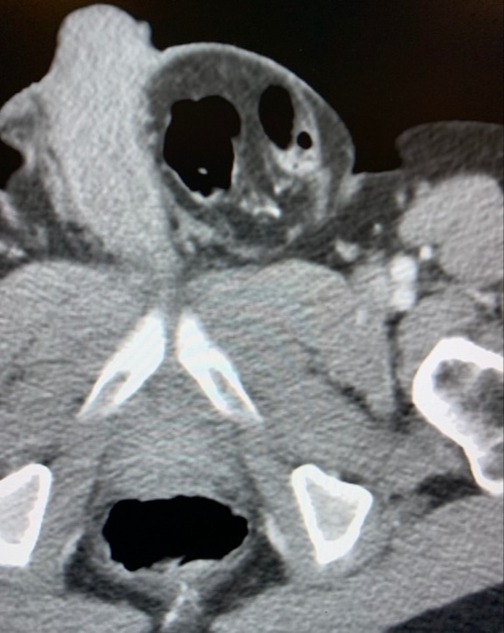Back


Poster Session E - Tuesday Afternoon
Category: General Endoscopy
E0285 - Should Endoscopists Look for an Inguinal Hernia Before Beginning a Colonoscopy?
Tuesday, October 25, 2022
3:00 PM – 5:00 PM ET
Location: Crown Ballroom

Has Audio

Shivam Shah, BS
University of Alabama
Bossier City, LA
Presenting Author(s)
Shivam Shah, BS1, Mel Wilcox, MD2, Yaser Aryanpure, 3, Sphurti Neelam, BS4, Adisesha Reddy, MD, FACG5
1University of Alabama, Bossier City, LA; 2University of Alabama at Birmingham, Birmingham, AL; 3University of Alabama, Tuscaloosa, AL; 4University of Florida, Riverview, FL; 5GastroCare P.C., Tuscaloosa, AL
Introduction: Colonoscopes can potentially become incarcerated in inguinal hernia sacs during routine colonoscopies. The entrapment of colonoscopes may occur when patients present with unknown inguinal hernias. Entrapment can occur during the insertion or withdrawal of the scope. We report a case of a screening colonoscopy resulting in entrapment of a colonoscope in a left inguinal hernia, which was managed by applying pressure to the hernia site.
Case Description/Methods: AH is a 66-year-old, white male who presented to the ambulatory surgical center for a screening colonoscopy. During the procedure, the scope repeatedly ended up in the blind end. It was evident the patient had a left inguinal hernia, and the scope was entering the hernia sac (Figure 1). Subsequently, the endoscopist withdrew the scope to prevent scope entrapment in the hernia sac, while the assistant put pressure on the hernia site under the patient’s gown to reduce the hernia sac. The colonoscopy was reattempted, while the assistant continued to push on the hernia site, and the procedure was completed without further difficulties.
Discussion: There have been two previous case reports of scope entrapment in a patient’s hernia sac resulting in the scope being removed using either surgery, fluoroscopy, or the pulley method.1, 2 It is best to avoid performing a colonoscopy for patients with an irreducible hernia. For a reducible hernia, applying pressure on the hernia site may ensure that the scope does not enter the hernia sac. If a patient has an unknown hernia in an open-access colonoscopy, then the endoscopist may not be prepared for a hernia until they start the procedure. Gastroenterologists should be aware of the consequences of patients presenting with unknown inguinal hernias, especially if they are irreducible, to avoid potential complications and emergent operations. Physicians performing colonoscopies should be cognizant of the potential risk to patients with large, irreducible inguinal hernias. Larger studies are needed to definitively mandate this recommendation.
References
1. Tan VP-Y. Incarceration of a colonoscope in an inguinal hernia: Case report and literature review. World Journal of Gastrointestinal Endoscopy. 2013;5(6):304. doi:10.4253/wjge.v5.i6.304
2. Torrealba M, Matlock R, Petrun B, Zera R, Malli A. Incarcerated colonoscope in a left inguinal hernia during diagnostic colonoscopy. ACG Case Reports Journal. 2021;8(4). doi:10.14309/crj.0000000000000564

Disclosures:
Shivam Shah, BS1, Mel Wilcox, MD2, Yaser Aryanpure, 3, Sphurti Neelam, BS4, Adisesha Reddy, MD, FACG5. E0285 - Should Endoscopists Look for an Inguinal Hernia Before Beginning a Colonoscopy?, ACG 2022 Annual Scientific Meeting Abstracts. Charlotte, NC: American College of Gastroenterology.
1University of Alabama, Bossier City, LA; 2University of Alabama at Birmingham, Birmingham, AL; 3University of Alabama, Tuscaloosa, AL; 4University of Florida, Riverview, FL; 5GastroCare P.C., Tuscaloosa, AL
Introduction: Colonoscopes can potentially become incarcerated in inguinal hernia sacs during routine colonoscopies. The entrapment of colonoscopes may occur when patients present with unknown inguinal hernias. Entrapment can occur during the insertion or withdrawal of the scope. We report a case of a screening colonoscopy resulting in entrapment of a colonoscope in a left inguinal hernia, which was managed by applying pressure to the hernia site.
Case Description/Methods: AH is a 66-year-old, white male who presented to the ambulatory surgical center for a screening colonoscopy. During the procedure, the scope repeatedly ended up in the blind end. It was evident the patient had a left inguinal hernia, and the scope was entering the hernia sac (Figure 1). Subsequently, the endoscopist withdrew the scope to prevent scope entrapment in the hernia sac, while the assistant put pressure on the hernia site under the patient’s gown to reduce the hernia sac. The colonoscopy was reattempted, while the assistant continued to push on the hernia site, and the procedure was completed without further difficulties.
Discussion: There have been two previous case reports of scope entrapment in a patient’s hernia sac resulting in the scope being removed using either surgery, fluoroscopy, or the pulley method.1, 2 It is best to avoid performing a colonoscopy for patients with an irreducible hernia. For a reducible hernia, applying pressure on the hernia site may ensure that the scope does not enter the hernia sac. If a patient has an unknown hernia in an open-access colonoscopy, then the endoscopist may not be prepared for a hernia until they start the procedure. Gastroenterologists should be aware of the consequences of patients presenting with unknown inguinal hernias, especially if they are irreducible, to avoid potential complications and emergent operations. Physicians performing colonoscopies should be cognizant of the potential risk to patients with large, irreducible inguinal hernias. Larger studies are needed to definitively mandate this recommendation.
References
1. Tan VP-Y. Incarceration of a colonoscope in an inguinal hernia: Case report and literature review. World Journal of Gastrointestinal Endoscopy. 2013;5(6):304. doi:10.4253/wjge.v5.i6.304
2. Torrealba M, Matlock R, Petrun B, Zera R, Malli A. Incarcerated colonoscope in a left inguinal hernia during diagnostic colonoscopy. ACG Case Reports Journal. 2021;8(4). doi:10.14309/crj.0000000000000564

Figure: Figure 1. CT of the abdomen revealing left inguinal hernia
Disclosures:
Shivam Shah indicated no relevant financial relationships.
Mel Wilcox indicated no relevant financial relationships.
Yaser Aryanpure indicated no relevant financial relationships.
Sphurti Neelam indicated no relevant financial relationships.
Adisesha Reddy indicated no relevant financial relationships.
Shivam Shah, BS1, Mel Wilcox, MD2, Yaser Aryanpure, 3, Sphurti Neelam, BS4, Adisesha Reddy, MD, FACG5. E0285 - Should Endoscopists Look for an Inguinal Hernia Before Beginning a Colonoscopy?, ACG 2022 Annual Scientific Meeting Abstracts. Charlotte, NC: American College of Gastroenterology.
